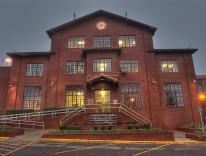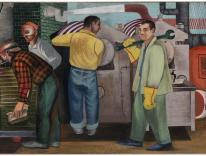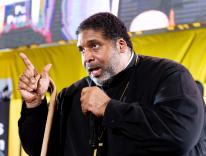Can’t Breathe
In the spring of 2020, the ambulance sirens never stopped wailing in the Bronx. Covid galloped through the borough, a sub-city of 1.4 million people, claiming 150 lives a day that April. Montefiore Hospital, the borough’s biggest hospital—and one of its major employers—turned every unused space over to Covid patients. North Central Bronx, the public hospital next door, lined them up in the hallways. City government made plans for a field hospital in Van Cortlandt Park, sandbags stacked at the edge of the famous cross-country course. After years of austerity budgets and efficiency consultants, both hospitals had far fewer beds than Covid demanded. An informal network of nurses maintained a text chain monitoring which area hospitals were accepting patients and which were turning them away. Montefiore brought in a trailer-sized supplemental oxygen tank to feed the many respirators pumping away inside—and refrigerator trucks for the bodies of those for whom the respirators were not enough. The morgue had far exceeded capacity.
The daily number of reported positive cases that spring peaked at 1,300, exacerbated by the cramped housing conditions in which tens of thousands of Bronxites live; by the fact that the borough, New York’s last refuge for the working class and poor, was filled with Black and Latino service-industry workers who didn’t have the option of working from home; and by the underlying chronic respiratory conditions that have long plagued the people of the Bronx, where highways run even through the parks. As workplaces shuttered and jobs in the informal economy disappeared, food pantries and soup kitchens were overwhelmed. By June, tens of thousands were receiving food assistance and lines at distribution sites—schools, churches, community centers—snaked around the block. In time, the pandemic would extract a heavy toll from communities all across the country and the world, but in those early months the Bronx was at its epicenter.
By summer 2020, as the country exploded in protest against racism after the murder of George Floyd, it appeared Americans were finally able to see the interlocking injustices Covid had exposed. “Now the world knows what we already knew for so many years,” Wanda Salaman said wearily. It was now the summer of 2021, and Salaman was sitting at a wooden picnic table in a community garden on East 181st Street, a few blocks west of the Bronx Zoo. This is the neighborhood in which she came of age and where she first got involved in community work nearly forty years ago. She began this work under the tutelage of Sr. Pat Dillon, RJM, and Astin Jacobo, a union organizer and former MLB scout who worked as a janitor at the local parish school. For years Jacobo—everybody called him Jacob—used the basketball teams he ran at St. Martin of Tours to collect intelligence on the landlord neglect that beset the borough in the seventies and eighties. He referred kids who reported they had no heat or water in their apartments to Dillon, the Bronx-native nun and community organizer. She would visit their parents and get them involved in the Crotona Community Association, part of the Northwest Bronx Community and Clergy Coalition (NWBCCC). The groups took the landlords to court and in some cases helped tenants take over their buildings.
Those first months of the virus in 2020 sent a lot of people who survived the Bronx in the seventies and eighties reaching for the lessons of their past. The Bronx has seen bad times before. Its fixes came local. Salaman is now executive director of Mothers on the Move (MOM), an advocacy group that works for better public health and economic change. For years MOM battled the truck traffic that earned a line of South Bronx neighborhoods the nickname Asthma Alley. In the late 1990s MOM staged sit-down protests on the Sheridan Expressway, demanding that the highway be demolished. It advocated for tenants in overcrowded apartments where dilapidated conditions led to mold and roach infestations that further imperiled respiratory health. And it demanded proper staffing at the hospitals and health clinics that serve the South Bronx. MOM has also drawn attention to the precarious position of undocumented workers excluded from the formal economy, and decried the city’s failure to provide viable neighborhood services even as mayors opened the public purse with tax breaks for the New York Yankees and FreshDirect. Founded in the 1990s as an advocacy group for education, MOM argues that all the crises in the Bronx are connected, each building on and compounding the others. Salaman and her colleagues have always had a clear understanding of the systemic failures that make life—and health—more precarious here. “We’ve been saying this is the problem but nobody’s been listening. Now a lot of people have the same understanding.”
It didn’t take Covid for people in the Bronx to know that public health, racism, and economics are intertwined, that an economy predicated on exploitation makes people sick. Covid’s spring 2020 assault on the Bronx came after years of anguish over rising rents and mounting precarity, as investors bought real estate like pork-belly futures and sent agents to scare away as many tenants as possible with illegal eviction notices and buyout offers. Meanwhile, the gig economy eroded the few protections workers once enjoyed. (Landmark tenant-protection legislation enacted in August 2019 promised a long-term shift in the dynamics of housing in NYC, but it was only beginning to be felt when Covid struck.)
“There’s always these studies, these white papers on how to fix the Bronx,” Salaman said as she leaned across the bright green picnic table. “They always pay someone who lives in West Bumblefuck to tell us what to do. Look, people here, we’ve got master’s degrees in poverty. Because we’ve been living it. The people who are going to save our asses are the people in the community.”
I’m not sure how time moves in other places, what dates echo loudest and which years loom largest. Maybe in Boston they are always thinking about busing or in Los Angeles about Rodney King. In New York, it’s a scratch on the vinyl record: all modern history began with the fiscal crisis on the mid-1970s and the city’s responses to it. We’re forever frightened of feeling its cold breath on our neck. The city made a lot of decisions then that tumbled down the years like a bowling ball down a staircase. It gave central Manhattan real estate to a racist developer from Queens who turned the city’s largesse and a variety of other flimflams into the presidency of the United States. It slashed arts and music education in schools and strangled the public-university system. It closed firehouses and cut housing inspectors. In waves of neglect and arson that were the culmination of decades of racist public policy—from 1930s redlining to 1960s urban renewal to the fiscal crisis ten years later—40 percent of buildings in some South Bronx neighborhoods burned between 1970 and 1980. More than a hundred thousand people fled. The people who stayed lived among blocks of rubbled wasteland, apartment buildings simply abandoned by owners and a city government openly advocating a policy called “planned shrinkage”: withdraw services, hope people leave, turn the neighborhoods over to industrial use. In popular memory, this is Fear City, the bad old New York of stalled subway trains and repeat muggings, chain link across park-house doors and job cuts for city workers. The gutting of NYC in the seventies gave rise to the crack, guns, and AIDS epidemics of the eighties. It’s a specter that still haunts New York political life. In the summer of 2020, we kept catching a glimpse of it out of the corner of our eye as we paced nervously on the subway platform. From their homes in the Hudson Valley and Eastern Long Island, New York editors assigned stories about the collapse of the city. They tuned up their instruments to play the dirges. A variety of stimulus interventions drove the ghost of the seventies back into his subway tunnel. But we know he’s still in there.
What’s missing from the nightmare memories of the bad old days is the work of the unglamorous neighborhood groups that brought them to an end—tenant associations and community organizations, frequently conceived by churches, often led by women, in many cases women of color, always led by poor and working-class people and their recently college-educated children. It’s their work that held communities together and made recovery possible. If the ghost of fiscal-crisis NYC stalked the city in the summer of 2020, so did the phantasms of stocky blue-collar block captains in batas—the colorful housedresses of Puerto Rican grandmothers—who called out the city fathers, wrested services from a government that wanted them gone, and stitched together a survival plan.
Seeing in the Dark
In those first months of Covid, groups that had been focused on housing, education, the arts, and economic development shifted to emergency provision of food, turning funding from the city council into bags of rice, yuca, macaroni, eggs. Grocery stores were picked over and the cash economy was teetering. Salaman made forays to Pennsylvania to buy toilet paper and antibacterial wipes she could share with neighbors. But while they pivoted to providing for the most basic needs, these local organizations were already making plans for the post-Covid future.
By fall, infection rates were galloping again, schools were closed, and Bronx neighborhoods were straining under the unprocessed grief of thousands of dead. The crisis was turning from acute to chronic. By May 2022, the state’s emergency rental-assistance program would pay out $440 million to cover back rent in the Bronx. But thousands of tenants still have five-digit rental arrears, according to a report by the Association for Neighborhood & Housing Development. A moratorium on evictions enacted at the beginning of Covid ended in January 2022, flooding housing court with pent-up cases. The highest rates in the city were in Bronx neighborhoods, according to the Right to Counsel Coalition, which advocates for tenants facing eviction. The unemployment rate in the borough has also stayed stubbornly high, even amid much national talk of the difficulty of filling jobs. In August 2022 the national unemployment rate was 3.8 percent. In the Bronx it was more than double that: 9.5 percent. Stimulus checks and advance child tax credits that provided middle-class families with a welcome financial buffer often didn’t find their way to people who hadn’t filed tax returns and don’t have bank accounts. Adjustments at the edge of the economy—even the massive government interventions that occurred during Covid—are insufficient, veteran Bronx activists argue. Trimmings from the edge of the pie can’t rectify a fundamentally exploitative system.
It was in the fall of 2020 that people gathered to come up with a new plan for the borough. They wanted to think beyond the immediate crises they’d always raced to address. They started asking bigger questions: What is it we actually want? If we could imagine a better Bronx, what would it be? All through the dark months of that dark year they logged onto Zoom calls, put aside grant reports and food-distribution spreadsheets, and dared to dream.
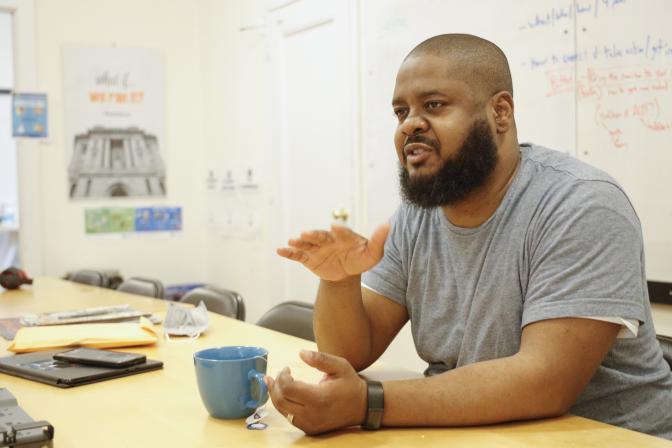
Convening many of these meetings was Michael Partis, a thirty-six-year-old Fordham grad who grew up in the South Bronx. The child of Belizean parents from the Garifuna ethnic group, Partis pursued a PhD in anthropology at the City University of New York before leaving to work in an education nonprofit in the Bronx. Just before Covid hit, in early 2020, he became executive director of the Bronx Cooperative Development Initiative (BCDI), a co-op incubator that’s trying to shift how people in the Bronx interact with the economy.
“This is a long-term economic development plan,” he explained on a sunny morning in June, in the rambling former parsonage just south of Fordham Road that is the BCDI headquarters. “Typically, bureaucrats have been doing the planning for local communities and it hasn’t worked out so well.” Instead BCDI, in partnership with MOM, NWBCCC, The Point Community Development Corporation (The Point), and a handful of well-established groups in the Bronx, is creating a plan for the borough’s economy drawn from native expertise. “We are hosting people’s assemblies to make sure the process is community-driven, community-led, and that the plan represents what the people want the economy to look like long-term, not short-term,” Partis said. The architects of the Bronxwide Plan are looking thirty years ahead. So often their work is stuck in crisis-response mode. Now they want to think long term, so that they take power over the economic forces that have battered the Bronx. But thinking big takes practice. Participants in assemblies and listening sessions are asked to think beyond the provision of direct services like after-school tutoring or food pantries, and instead to consider an entity in the neighborhood that’s already working well—maybe a farmers’ market, or a childcare co-op—and that could be expanded or transformed to create a shared economic stake in the community.
A youthful-looking man with an easy smile, Partis worked for months from home, his three young children occasionally rushing across the screen at Zoom meetings. “What we’ve gotten during Covid is a lot of trickle-down money. It has been helpful—but this is what happens when it’s not structural. The money will run out and then what? We still haven’t solved the structural problems in our neighborhoods.”
If we don’t want this crisis after crisis, the leaders in the Zoom meetings asked each other, what is it that we do want? For more than a year they formulated goals that covered housing, education, manufacturing, health, energy and the environment, transportation, and food—all focused on policies that would build communal wealth. There has never been a shortage of money in the Bronx; it’s just that so much of the wealth generated here leaves. The borough has been making people rich for a long time. Apartment buildings full of poor tenants paying half their income in rent generate tremendous profit for landlords who are willing to skimp on maintenance and leverage properties as debt instruments. Commercial districts like Fordham Road and the Hub funnel billions of dollars to corporations with stores there. The Amazon warehouses that brought yet more truck traffic to the South Bronx during the pandemic added to Jeff Bezos’s stratospheric wealth. Partis and his colleagues wanted to find a way to keep that money in the neighborhood, so that the residents of the Bronx would have a stake in the borough’s economy. “We want to give people something to look forward to, to build to,” Partis said.
On a breezy Saturday at the end of June about 150 people gathered in Hunts Point Riverside Park for the first in a series of open-air public assemblies to solicit specific ideas from people in nearby neighborhoods—and to introduce the Bronxwide Plan itself to a wider audience. The assembly was hosted by The Point, which has worked for thirty years to build community and improve conditions in Hunts Point. Hunts Point Riverside Park stretches from the truck-heavy Hunts Point Avenue to the bucolic Bronx River, where another local group, Rocking the Boat, runs a sailing camp for local kids and takes them seining—fishing with nets to explore the fauna of the river. There’s a picnic atmosphere in the park today. Music plays while people spray-paint colorful posters extolling the Bronxwide Plan and staff from various participating organizations talk to visitors about community solar initiatives, ideas for free WiFi networks, and initiatives that would allow food vendors to make their businesses more sustainable.
Today’s assembly capped off the annual fish parade—an ebullient neighborhood march from The Point’s headquarters on Garrison Avenue here to the shores of the river. It started twenty years ago as a protest against city government’s plan to relocate the giant wholesale Fulton Fish Market to a neighborhood already burdened by too much truck traffic. The protest was unsuccessful—the new fish market opened—but a tradition was born of marching to the river and introducing neighbors to the hidden beauty behind the warehouses. In the parade’s first years, people processed—in exuberant homemade fish costumes—to Barretto Point Park on the other side of the peninsula. “In the beginning it was about saying how do you get to the park safely,” explained Danny Peralta, longtime director of arts and education for The Point and newly appointed director of En Foco, a forty-five-year-old South Bronx photo gallery devoted to advancing Nuyorican artists. “In the parade we’d honor people who don’t get recognized by the newspapers, but who are the real people who keep a neighborhood together.” In more recent years the parade’s destination has become this pleasing parenthesis of a park, just blocks from the Bruckner Expressway. “The metaphor is the school of fish marching together,” Peralta told me. “I think this is important—we have this waterfront community. We do march together. That’s the beautiful thing in this neighborhood. That’s how we move.”
Hunts Point Riverside Park is one of a network of parks along the southern stretches of the river, all of them born from the unrelenting demands of neighborhood people. Men whose day of work is done now walk to the river with fishing rods leaned against their shoulders, toting plastic contractor buckets filled with bait fish. Once choked with debris and toxic with chemical waste, the river has been reclaimed after tenacious local advocacy for federal clean-up funds. Volunteers spent hundreds of Saturdays hauling garbage and planting trees. Now every summer weekend the Bronx River Alliance runs canoe trips down the river, where paddlers see egrets, herons, cormorants, and tiny herring returning to their spawning grounds.
Better Ghosts in Yolanda Garcia Park
Yolanda Garcia was among those fierce and loving Bronxites who stayed. After the fires, her Melrose neighborhood along Third Avenue near 150th Street was pockmarked with vacant lots and half-demolished buildings. When she learned in 1992 that city government was preparing to impose a top-down urban-renewal project on the neighborhood, displacing thousands of residents who had held on during the bad years, she rallied neighbors. The city would have to scrap any plan the neighborhood hadn’t approved. Working with urban planner Petr Stand, the group created the Melrose Commons Plan, a roadmap out of disaster. It was a blueprint for the neighborhood they thought they deserved. Nos Quedamos (“We Stay”) is the nonprofit housing developer and community organization Garcia and others eventually founded.
The Melrose Commons Plan called for zero displacement, a mix of owning and renting, a footprint that respected the streetscape and pedestrian flow of the neighborhood, environmental sustainability, and attractive, high-quality buildings. In 1994 the plan was approved by the city government and adopted by the department of city planning. It was bottom-up planning: design and use determined by the people who knew what their neighborhood needed and who wedged a chair up to the table where the city made decisions. The Melrose Commons Plan is now studied in city-planning classes and written about in books of urban theory. In 2019, just before Covid shut down the city and the world, Nos Quedamos completed its vision, dedicating the last of twelve community gardens within the thirty-three-block area where they manage apartments for four thousand families. The population of the neighborhood has rebounded in the thirty years since the plan was approved. In that time, Yolanda died and Petr’s beard grew grey, then white. A Puerto Rican neighborhood became a Puerto Rican, Mexican, Dominican, West African, Bangladeshi neighborhood. Employment shifted from garment work to health care, and the financial mechanisms for building apartments changed. Bankers came to understand the profit that could be made from low-income housing. Some of the ideas that were once considered utopian became commonplace. The Bronxwide Plan takes some inspiration from the Melrose Plan of a generation ago.
It was breezy in Yolanda Garcia Park at 160th Street and Melrose Avenue as late afternoon sun set the bricks glowing one Sunday in July 2021. A few dozen people stretched out on the green grass, which breathed oxygen into a neighborhood of heat and bus exhaust. Kids played on a jungle gym. Four hip Boricua actors strode to the center of the park and stepped to microphones in front of conga players who had been calling the beat all afternoon. From Bayamón to the Bronx, tropics to tenant meetings, it’s a five-hundred-year rhythm reaching across time and oceans: talking drums in Ghana turned to Bomba in the Caribbean and salsa then hip-hop in El Bronx. The actors began a chant: Dios mío, protege mi edificio, channeling the incantation of their grandmothers, who grabbed rosaries when they smelled smoke during the burning in the seventies and eighties. The play, directed by Rosalba Rolón, is called TORCHED!. It premiered at the Pregones Theater a year later. It tells the story of the destruction of the Bronx, but it’s also about today and tomorrow—how the Bronx will survive this time. It’s a bit like a séance, calling up these ghosts in this very place: a lot that held a cluster of apartment buildings burned one year, razed to rubble several years later, then left as a reminder of neglect for many years more. Now it’s a park hosting theater and music. The city officially designated it Yolanda Garcia Park in 2018.
On a sweltering Sunday afternoon in the narrow side yard beside the Pregones Theater on 150th Street, a band flown in from Puerto Rico plays for a rapt crowd. Jessica Clemente, the current executive director of Nos Quedamos, holds the shoulders of her two young sons. “I wanted them to see this,” she said. “They need to know what community is, to experience the culture.” Clemente has been with Nos Quedamos since college. She grew up in the Mill Brook public-housing development nearby and returned from college in upstate New York to work for Garcia, hired to help with an asthma study in the early 2000s. She stayed on. Nos Quedamos implemented the Melrose Commons Plan poco a poco: another garden, another building, another housing lottery to get people into apartments where families could thrive. The city ordered community gardens closed to the public during the worst months of Covid, but the gardeners kept up, coaxing food from the soil, setting out boxes of greens and tomatoes for neighbors. When restrictions eased, the gardens became places where locals could break the loneliness of long confinement.
Before Covid, Nos Quedamos applied for a $650,000 grant from Empire State Development—the state government’s economic development arm—for a sustainability project that will install solar canopies in the gardens, capturing rainwater and recirculating irrigation. “These resiliency hubs would have enough power to charge 150 laptops. Then you could have refrigeration. We know a crisis is going to come. This isn’t the last one,” Clemente said. Nos Quedamos is a key member of the group working on the Bronxwide Plan. Clemente is optimistic, but also clear-eyed. “There are a lot of challenges in our neighborhood, but I want to lean on our strengths,” she told me. “You have to lean on organization, the leverage of policy and advocacy. Because change comes when you change policy.”
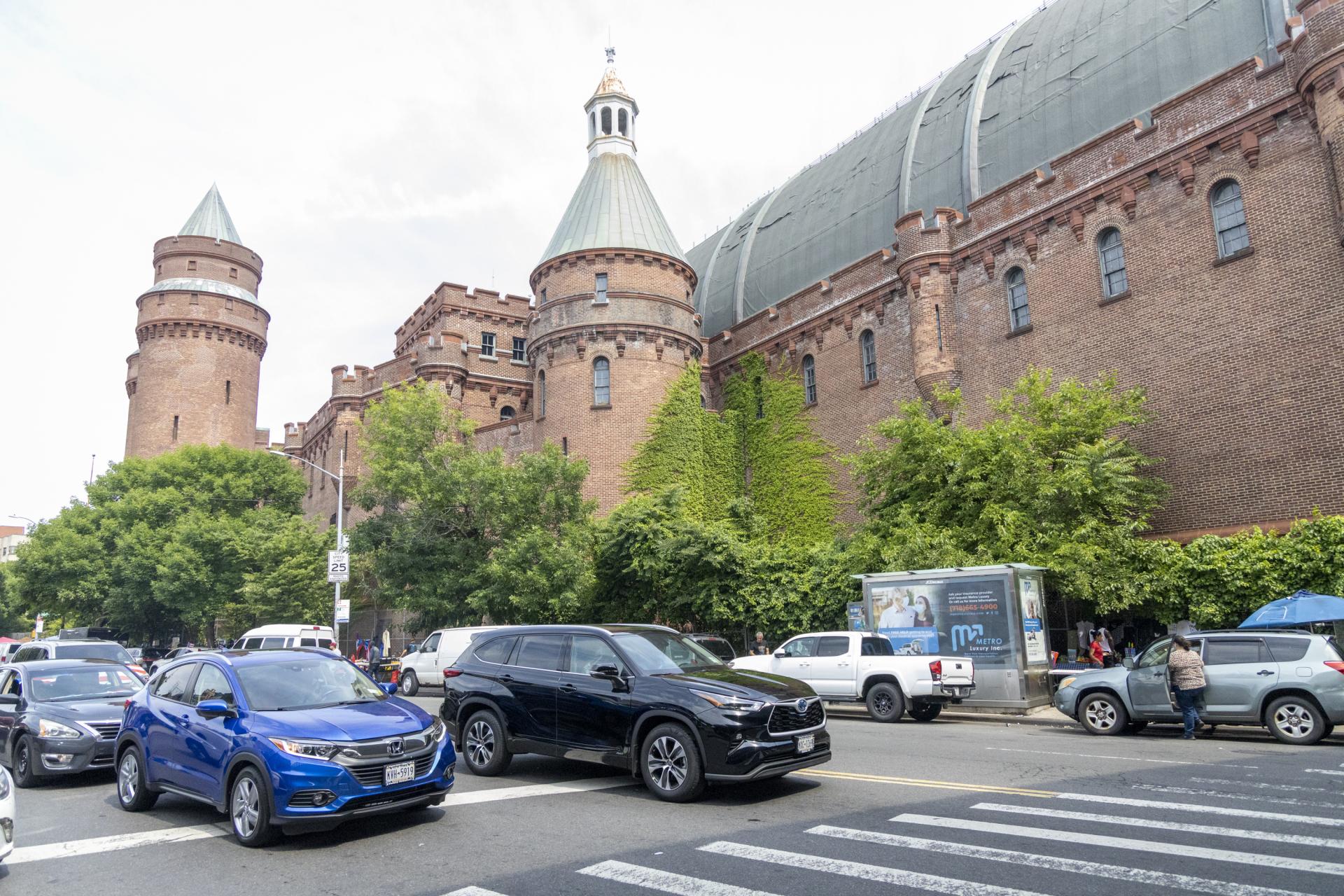
In the Shadow of the Armory
The Kingsbridge Armory was built between 1912 and 1917 to house the National Guard and keep control of radicals and restive immigrant workers—one of a dozen looming castles that mushroomed about the city between the Gilded Age and World War I. The armory’s drill hall, just one portion of the building, is the size of two football fields. There is an eight-hundred-seat auditorium. And a moat. It is nine stories tall and occupies a five-acre superblock that is a quarter-mile long. It feels like a Duplo set in a Lego neighborhood. Owned by the city and mostly vacant since the 1990s, the Kingsbridge Armory has been the subject of intense wrangling between community organizations, local politicians, and the economic development teams of a series of New York City mayors. In the mid-nineties, parents in this severely overcrowded district wanted to see it turned into schools. Mayor Giuliani wanted to build a mall. In the early aughts, local groups wanted to turn it into a giant community center with basketball courts and mom-and-pop businesses. Mayor Bloomberg wanted to replicate Chelsea Market, courting high-end epicures. The Kingsbridge Armory Redevelopment Alliance—a partnership between the NWBCCC, the retail-workers union, and a variety of local groups—demanded a say in what developer was selected and defeated a proposal by the politically connected Related Companies. Improbably, a group fronted by a former NHL player convinced the city and the neighborhood that the armory should house the world’s largest ice-skating center. In 2013 the Kingsbridge Armory Redevelopment Alliance brokered a community-benefits agreement that promised a million dollars’ worth of free ice time to local schools and community groups, guarantees for local hiring, and jobs with living wages. People started joking that in twenty years the NHL would be mostly Dominican. But for almost ten years nothing happened. The developer hadn’t secured sufficient investment. The deal collapsed. In fall 2021, the city retook control of the building.
In the shadow of the armory there had long been a woman with a small cart selling empanadas to people exiting the 4 train at Kingsbridge Road. Another woman occupied her place during the morning rush hour, her granny cart stacked with coolers full of tamales, and a twist-off thermos full of arroz con leche. But as the economic dislocation of Covid wore on, the wide apron of sidewalk beside the armory sprouted more and more vendors. Now fold-out tables and blankets spread on the ground stretch the full length of the superblock. For sale: sneakers and old coats; scuffed high heels pulled from the back of the closet; medical gowns garnered from who-knows-where; pots and pans and household knickknacks; bins full of plastic Happy Meal toys; DVDs and VHS tapes; phone cases in every color, studded with rhinestones; chunky necklaces with pendants of the Divino Niño, his plump toddler arms outstretched.
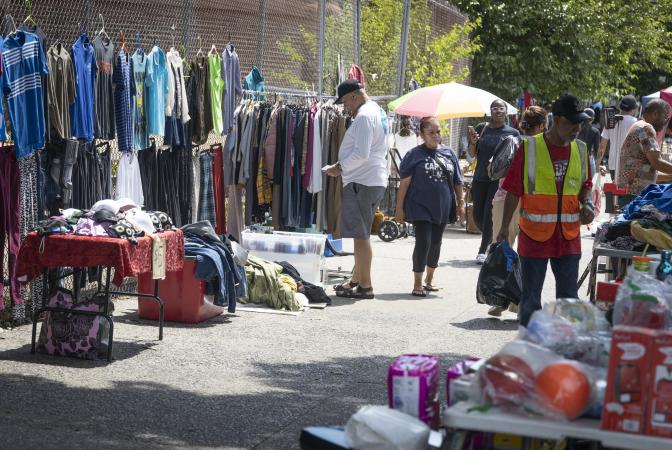
Rasel sells clothes and is proud of the sneakers he has on offer today: “Mint condition,” he says, turning them over to reveal virgin soles. “Look at that. Nikes, LAX edition. Online these are like $155. I’m selling them for $35.” Rasel finished college more than a decade ago but lost his job during Covid. “I started coming out here about eighteen months ago,” he says on a breezy day in May 2022. “A lot of people make their living here.”
Ariel sits in the back of his van, hemmed in by eight folding tables pushed close together. Each of them is laden with workman’s tools: ratchet sets and electric drills, hand sanders and screwdrivers. He buys them wholesale in New Jersey or Connecticut and resells them here. “Before Covid, I sold fruits and vegetables,” he explains in Spanish as he surveys the table. “I came from Bayamón, Puerto Rico, four years ago.” Hundreds of thousands have been driven from the island by the debt crisis, Puerto Rico’s economy and governance dictated by bondholders much as New York City’s was when austerity reined and the Bronx burned. Ariel sees a man he knows approaching. “Primo, I have a good little machine for you,” he says, carefully reaching for a red canvas tool bag inside his van. He hands the customer a small electric drill. They haggle and banter a while before the customer moves on: no sale. Ariel wakes before 4 a.m. in Hunts Point, loads the van and begins setting out the tables by 5 a.m. He packs up at 8 p.m., after the last of the commuters trickle off the 4 train and glance at his wares. On a good day, he makes $150.
George has been selling at the Kingsbridge bazaar for a year and a half, after losing his job as a delivery driver during the pandemic. “We had to pay rent,” he said. “Too much rent. We have to do something to survive.” He explained that a friend told him about auctions at U-Haul, where goods left in storage lockers are sold off by the lot: tools, electronics, microwaves, and toaster ovens.
Darrell Edwards, a union electrician in his fifties, has been at the bazaar for more than a year, selling out the contents of his closets. “The Covid took me to where I had to do that if my family was going to eat,” he said. “I was never used to this. I told my wife, we got a lot of stuff, let’s see if we can sell it. On a good day, if you got good stuff, you might make a hundred dollars. Two dollars here, five dollars there. It’s not like it’s Saks Fifth Avenue,” he chuckles. “The armory wants to push people away, tells us not to hang stuff on the fence. But people are just trying to survive.”
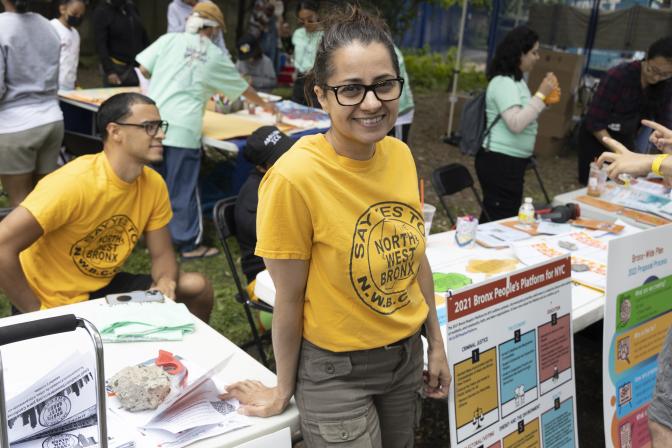
The people designing the Bronxwide Plan want the armory, long a symbol of domination and disregard, to be part of a new Bronx economy, where people can do more than survive. They aren’t asking for a seat at the table for this round of planning on the behemoth. They want to own the table, and turn the seats into co-ops, something that builds wealth with the people of the borough. This spring, the NWBCCC relaunched the armory campaign. Sandra Lobo, the NWBCCC’s executive director, was a college student at Fordham when the armory fight began in the 1990s. Now she’s a respected Bronx leader. In April, the NWBCCC convened strategy sessions. They pulled in elected officials who are sometimes political allies. They designed another flyer, came up with a new slogan. They know much more this time.
The Bronx has been through hell before. What built it back was a thousand tenant meetings and smart lobbying that demanded and finally won reinvestment. Those community activists pioneered new ways to build and manage multifamily housing. They picketed at commissioners’ Westchester County homes until there was money for summer programs in the parks and housing inspections of shoddy buildings. When the Department of Sanitation said it couldn’t clean the lot on 180th Street where it dumped the refuse of demolished buildings because it was worried the bulldozers would be stolen, Sr. Pat set out a lawn chair and slept outside to guard the city’s bulldozer. That lot is now a city park with a playground, a meditation garden, and a ball field. A tenacious movement of hard-nosed visionaries showed what was possible. Combined with the entrepreneurial and cultural energy of the 1990s immigration surge, the borough breathed again. It never got easy here, but it got better.
The Bronxwide Plan sometimes seems too utopian—like it might float away on the airiness of activist rhetoric or sink under the weight of grad-school theorizing. But then the comptroller announces that the city will explore ways to transfer tax-delinquent properties to housing providers, and the state assembly holds hearings on a public bank; the city council allocates funds to groups developing land trusts, and the state legislature mandates a raise for home health aides. A few years ago, the U.S. Department of Transportation dismantled much of the highway MOM had been protesting since the 1990s, and the NYC Department of Health now states on its statistics pages that racial and ethnic disparities in Covid death rates are the result of structural racism. Such things didn’t used to happen. What was once pie in the sky becomes commonplace.
Who will save the Bronx? The same people who always have.
Please email comments to [email protected] and join the conversation on our Facebook page.
Previous Story
Old Towns, New Havens
Next Story
The Tragedy of Evangelical Politics
